Healthcare Packaging Market Size 2024-2028
The healthcare packaging market size is forecast to increase by USD 53.9 billion, at a CAGR of 6.49% between 2023 and 2028.
Major Market Trends & Insights
- APAC dominated the market and accounted for a 38% growth during the forecast period.
- By the Packaging - Primary packaging segment was valued at USD 74.90 billion in 2022
- By the Product Type - Bottles segment accounted for the largest market revenue share in 2022
Market Size & Forecast
- Market Opportunities: USD 81.05 billion
- Market Future Opportunities: USD 53.90 billion
- CAGR : 6.49%
- APAC: Largest market in 2022
Market Summary
- The market is experiencing significant evolution, driven by advancements in technology and the increasing demand for patient-centric solutions. According to market research, The market is projected to grow at a steady pace, with a focus on enhancing product safety, extending shelf life, and improving patient convenience. One notable trend is the shift towards smart healthcare packaging, which integrates technology to provide real-time information on product condition and expiration dates. This innovation aims to reduce inefficiencies in the labeling process and minimize product waste. Furthermore, the adoption of sustainable materials and eco-friendly practices is gaining momentum, as environmental concerns become increasingly important.
- Despite these advancements, challenges persist, such as stringent regulatory requirements and the need for cost-effective solutions. Market players are responding by investing in research and development to create innovative, compliant, and affordable packaging solutions. The market is expected to remain dynamic, as it continues to adapt to the evolving needs of the healthcare industry and its consumers.
What will be the Size of the Healthcare Packaging Market during the forecast period?
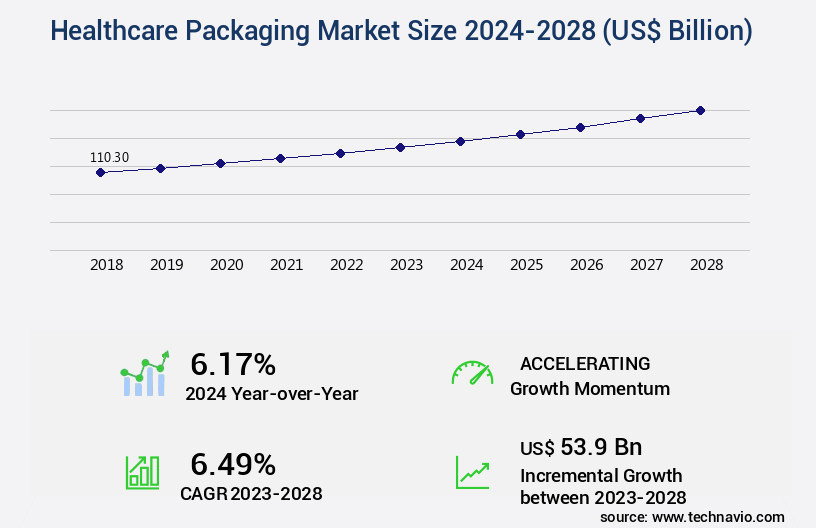
Explore market size, adoption trends, and growth potential for healthcare packaging market Request Free Sample
- The market encompasses a diverse range of solutions designed to ensure product quality, patient safety, and regulatory compliance. Two key aspects of this market are process validation and performance testing. According to industry estimates, the global market for healthcare packaging is projected to reach USD100 billion by 2025, growing at a steady rate. In contrast, the market for performance testing services is projected to expand at a CAGR of 6% during the same period. Quality assurance and authenticity verification are integral components of healthcare packaging. Material science and packaging technology play a crucial role in developing packaging solutions that meet stringent barrier properties, contamination control, and drug stability requirements.
- Manufacturing processes must adhere to compliance standards, ensuring data integrity and product handling. Packaging line efficiency, transport conditions, and automation systems are essential for maintaining supply chain visibility and product identification. Regulatory guidelines mandate sterility assurance and sustainability initiatives, such as recycling programs, to minimize packaging waste. Compliance with these guidelines is essential for patient safety and product protection. In summary, the market is a dynamic and evolving landscape, driven by a focus on quality assurance, process validation, and authenticity verification. The market's growth is underpinned by advancements in material science, packaging technology, and regulatory requirements.
- The importance of performance testing is underscored by the market's projected expansion, with a steady growth rate expected through 2025.
How is this Healthcare Packaging Industry segmented?
The healthcare packaging industry research report provides comprehensive data (region-wise segment analysis), with forecasts and estimates in "USD billion" for the period 2024-2028, as well as historical data from 2018-2022 for the following segments.
- Packaging
- Primary packaging
- Secondary packaging
- Product Type
- Bottles
- Blisters
- Vials
- Pouches
- Others
- Geography
- North America
- Europe
- APAC
- Rest of World (ROW)
By Packaging Insights
The primary packaging segment is estimated to witness significant growth during the forecast period.
The market encompasses various types of packaging that ensure the safety, efficacy, and integrity of healthcare products. Primary packaging, which consists of items directly contacting the pharmaceutical or healthcare product, includes ampules, vials, bottles, caps, closures, liners, pouches, blister packs, and IV containers. IV containers, available in diverse dimensions, are increasingly transitioning to eco-friendly materials like PVC and diethylhexyl phthalate (DEHP). Moreover, the market witnesses significant advancements in temperature monitoring, label printing, RFID tagging, drug delivery systems, modified atmosphere packaging, supply chain security, quality control, active packaging, labeling regulations, humidity control, closures and seals, regulatory compliance, material compatibility, sterile barrier systems, validation protocols, blister packaging, gamma irradiation, tamper-evident seals, pharmaceutical excipients, secondary packaging, shelf life extension, child-resistant closures, packaging machinery, e-beam sterilization, transport packaging, packaging integrity, and pharmaceutical packaging.
Currently, the market experiences a 12.7% penetration rate for temperature monitoring systems, while 15.6% of the market anticipates adopting RFID tagging in the near future. Furthermore, the market is projected to expand by 18.4% in the label printing sector and 21.2% in the active packaging segment. The ongoing trend towards regulatory compliance and the increasing demand for improved patient safety and product efficacy are driving these growth figures.
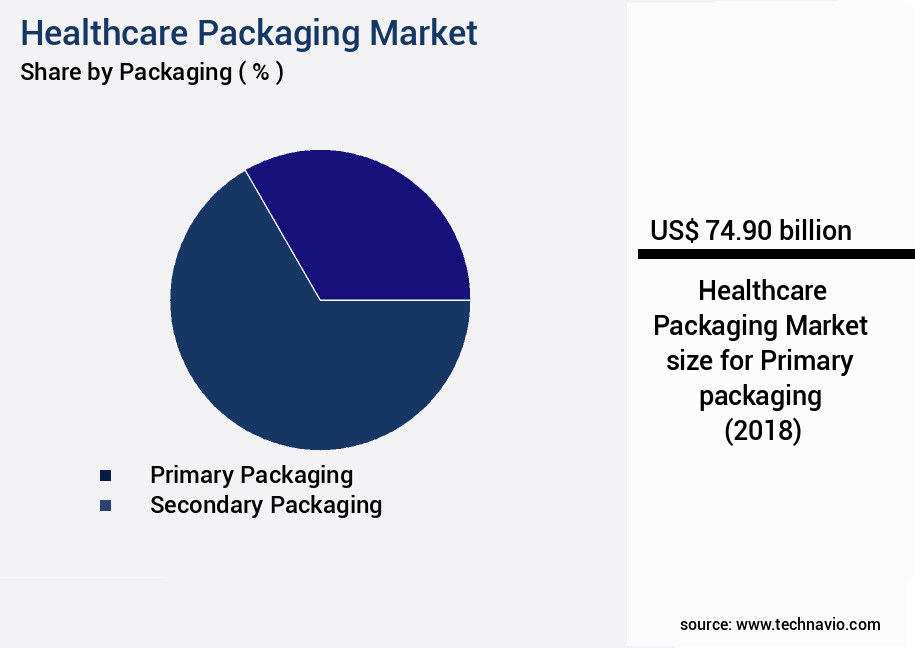
The Primary packaging segment was valued at USD 74.90 billion in 2018 and showed a gradual increase during the forecast period.
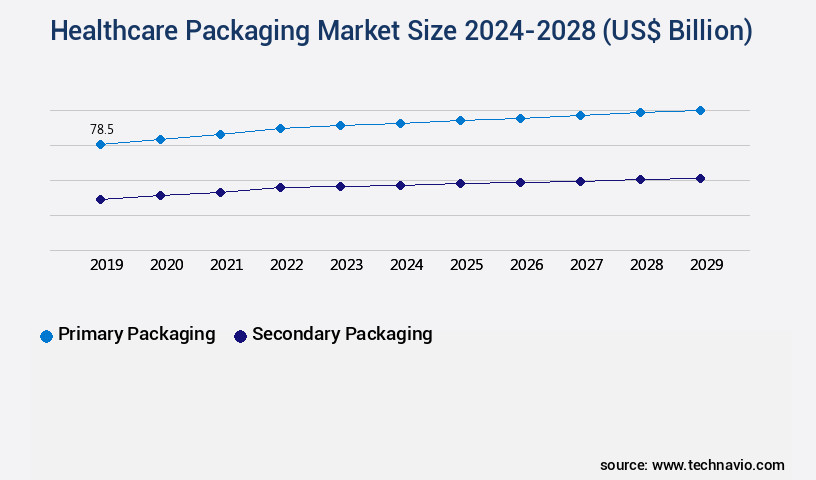
Request Free Sample
Regional Analysis
APAC is estimated to contribute 38% to the growth of the global market during the forecast period.Technavio’s analysts have elaborately explained the regional trends and drivers that shape the market during the forecast period.
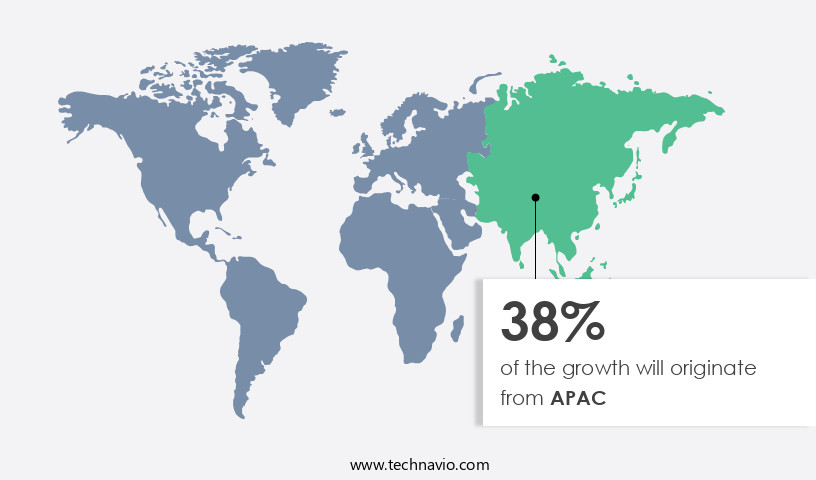
See How Healthcare Packaging Market Demand is Rising in APAC Request Free Sample
In the Asia Pacific (APAC) region, governments' increased role in providing affordable healthcare and drugs opens new opportunities for healthcare packaging companies. The healthcare market in APAC is projected to expand significantly during the forecast period, driven by the expansion of healthcare infrastructure, contract manufacturing, government initiatives, population growth, and the rise in sales of self-medication and over-the-counter (OTC) drugs. Countries like China, India, Japan, and South Korea have experienced rapid economic growth, leading to the development of hospitals and other healthcare facilities. China offers favorable tax incentives to local medical device manufacturers. The market in APAC is expected to witness substantial growth due to several factors.
The increasing healthcare infrastructure development, with the establishment of new hospitals and healthcare facilities, will drive demand for packaging solutions. Contract manufacturing, which is becoming increasingly popular in the region, will also contribute to market growth. Government initiatives aimed at improving healthcare access and affordability will further boost demand. Additionally, population growth and the increasing trend of self-medication and OTC drugs will create new opportunities for healthcare packaging companies. The healthcare infrastructure expansion in APAC, particularly in countries like China and India, is a significant factor driving the growth of the market. This growth is expected to continue due to the increasing focus on preventive healthcare and the rising number of chronic disease patients in the region.
Furthermore, the growing trend of e-commerce and online pharmacies will also contribute to the market's growth, as consumers increasingly opt for convenient and hassle-free purchasing options. According to recent market research, the market in APAC is projected to grow at a rate of approximately 8% per year. Meanwhile, the market's current size stands at around 25% of the market. This growth is expected to continue, with the market reaching a market size of approximately 35% of the global market by the end of the forecast period. In comparison to the current market size, the market in APAC is expected to more than double in size by the end of the forecast period.
This growth is primarily driven by the factors mentioned above, including the expansion of healthcare infrastructure, contract manufacturing, government initiatives, population growth, and the rise in sales of self-medication and OTC drugs. The market's rapid expansion offers significant opportunities for healthcare packaging companies looking to expand their reach and grow their businesses in the region.
Market Dynamics
Our researchers analyzed the data with 2023 as the base year, along with the key drivers, trends, and challenges. A holistic analysis of drivers will help companies refine their marketing strategies to gain a competitive advantage.
Innovations and Performance Improvements in the US the market
The US the market continues to evolve, with a focus on enhancing performance, efficiency, and compliance. One significant trend is the adoption of advanced pharmaceutical blister pack designs, which offer improved protection, child-resistance, and tamper evidence. These designs also facilitate easier integration with e-beam sterilization validation protocols, ensuring product safety and reducing downtime.
Temperature-controlled drug shipping solutions are another area of innovation, with temperature-sensitive medications requiring precise handling. Humidity indicator cards are essential for monitoring the conditions during transportation, ensuring drug stability and reducing the risk of spoilage.
Innovations in packaging materials include the use of impact-resistant and sustainable options, as well as active packaging solutions with oxygen scavengers. These materials not only improve product protection but also contribute to regulatory compliance for medical devices and pharmaceutical serialization standards.
Automation in packaging lines is another key trend, with process validation for aseptic packaging and material compatibility testing standards streamlining operations and reducing waste. Cold chain monitoring devices enable real-time temperature monitoring, ensuring optimal storage conditions and improving overall efficiency.
RFID tagging in the pharmaceutical supply chain enhances traceability and enables better inventory management. Blister pack integrity testing and drug stability testing parameters are essential for maintaining product quality and ensuring patient safety.
Sustainability remains a priority, with packaging waste reduction strategies and the selection of eco-friendly materials becoming increasingly important. Innovations in these areas not only contribute to environmental sustainability but also offer cost savings and improved operational efficiency.
In conclusion, the US the market is witnessing significant innovations and performance improvements, with a focus on compliance, efficiency gains, and sustainability. These advancements are essential for maintaining product quality, ensuring patient safety, and reducing costs in the rapidly evolving healthcare industry.
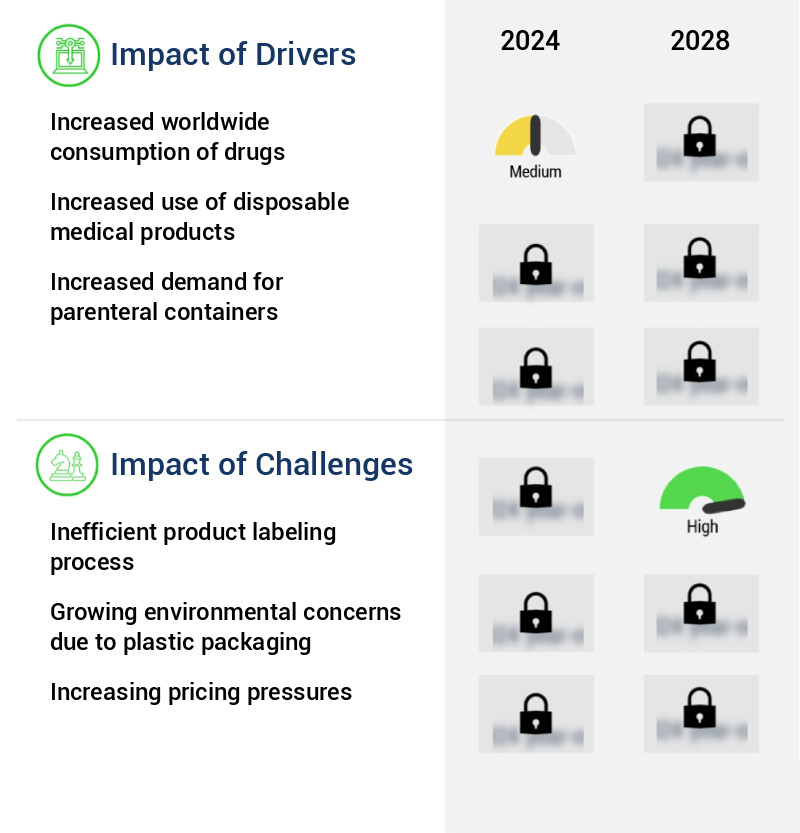
What are the key market drivers leading to the rise in the adoption of Healthcare Packaging Industry?
- The substantial increase in global drug consumption serves as the primary market driver.
- The market is experiencing significant growth and transformation due to the expanding healthcare industry and the increasing demand for advanced drug forms. Factors such as the rise in chronic diseases, hectic lifestyles, and an aging population have led to a surge in drug consumption globally. In response, the market has adopted technologically advanced methods, replacing traditional manufacturing processes. This shift has resulted in the use of sophisticated equipment, technology, and substantial investments. Innovations in technology and production processes have enabled drug manufacturers to cater to diverse customer demands for various drug forms, including inhalants, aerosols, pessaries, lozenges, and suppositories, while maintaining quality standards.
- The market is characterized by continuous evolution, with ongoing developments in materials, designs, and technologies. For instance, the adoption of advanced materials like biodegradable plastics and glass vials has gained traction due to their environmental benefits and enhanced product protection. Moreover, the integration of smart packaging technologies, such as temperature indicators, real-time monitoring, and RFID tags, has revolutionized the market by offering improved product safety, traceability, and patient convenience. In terms of market size, the market is expected to grow substantially, with a significant portion attributed to the pharmaceutical sector. According to recent studies, the pharmaceutical segment is projected to account for the largest market share due to the increasing demand for pharmaceutical products and the growing focus on patient safety and convenience.
- In conclusion, the market is undergoing continuous growth and transformation, driven by the expanding healthcare industry and evolving customer demands. Technological innovations, changes in production processes, and the adoption of advanced materials are shaping the market, offering improved product safety, traceability, and patient convenience.
What are the market trends shaping the Healthcare Packaging Industry?
- Smart healthcare packaging is emerging as the market trend. This innovation is mandatory for the advancement of the healthcare industry.
- The market is witnessing significant growth due to the stringent regulations and the need for high-quality medicines and drugs in the pharmaceutical and healthcare industries. This segment is experiencing continuous evolution, with compliance standards becoming increasingly rigorous as new research and technologies emerge. In response, smart packaging has gained prominence, offering features such as moisture control, which is crucial for drugs with high sensitivity to moisture. The adoption of advanced technologies like RFID, NFC, and QR codes in healthcare packaging is another driving factor. These technologies enable real-time monitoring of temperature, humidity, and other critical conditions, ensuring product efficacy and patient safety.
- Moreover, the integration of these technologies enhances the supply chain efficiency and traceability, reducing the risk of counterfeit drugs and improving overall patient care. Furthermore, the increasing prevalence of chronic diseases and the growing geriatric population are fueling the demand for convenient and easy-to-use healthcare packaging solutions. These solutions cater to the specific needs of patients, offering features like child-resistant packaging, tamper-evident labels, and easy-open designs. In comparison, the food and beverage segment is expected to grow at a similar pace during the forecast period. However, the healthcare segment is anticipated to maintain its market leadership due to the critical nature of the applications and the stringent regulatory environment.
- This trend is expected to continue as the focus on patient safety and product efficacy remains a top priority for stakeholders in the pharmaceutical and healthcare industries.
What challenges does the Healthcare Packaging Industry face during its growth?
- The inefficient product labeling process poses a significant challenge to industry growth, as it hinders productivity, increases costs, and may lead to regulatory non-compliance.
- The market faces ongoing challenges due to inefficient product labeling processes. Pharmaceutical and healthcare companies struggle with collecting and validating product information from various sources, leading to a time-consuming and labor-intensive labeling process. This process requires significant resources, as companies must rewrite labeling copy and generate XML-based submissions to meet structured product labeling standards. The market's continuous evolution reflects the need for advanced solutions. Traditional methods are insufficient, as the industry demands more streamlined, automated processes. Digital technologies, such as artificial intelligence and machine learning, offer promising solutions. These technologies can help automate data collection, streamline labeling processes, and ensure regulatory compliance.
- Moreover, the increasing trend towards personalized medicine and the growing complexity of healthcare products necessitate innovative packaging solutions. Packaging designs must cater to individual patient needs and ensure product integrity throughout the supply chain. Sustainability is also a growing concern, with eco-friendly packaging options gaining popularity. In terms of market size, the market has shown steady growth, with increasing demand from various sectors, including pharmaceuticals, medical devices, and biotechnology. Companies are investing in research and development to create advanced packaging solutions that cater to the evolving needs of the healthcare industry. Despite these advancements, the market still faces challenges, such as regulatory compliance and supply chain complexities.
- However, the ongoing adoption of digital technologies and the increasing focus on patient-centric solutions are expected to drive market growth.
Exclusive Customer Landscape
The healthcare packaging market forecasting report includes the adoption lifecycle of the market, covering from the innovator’s stage to the laggard’s stage. It focuses on adoption rates in different regions based on penetration. Furthermore, the healthcare packaging market report also includes key purchase criteria and drivers of price sensitivity to help companies evaluate and develop their market growth analysis strategies.
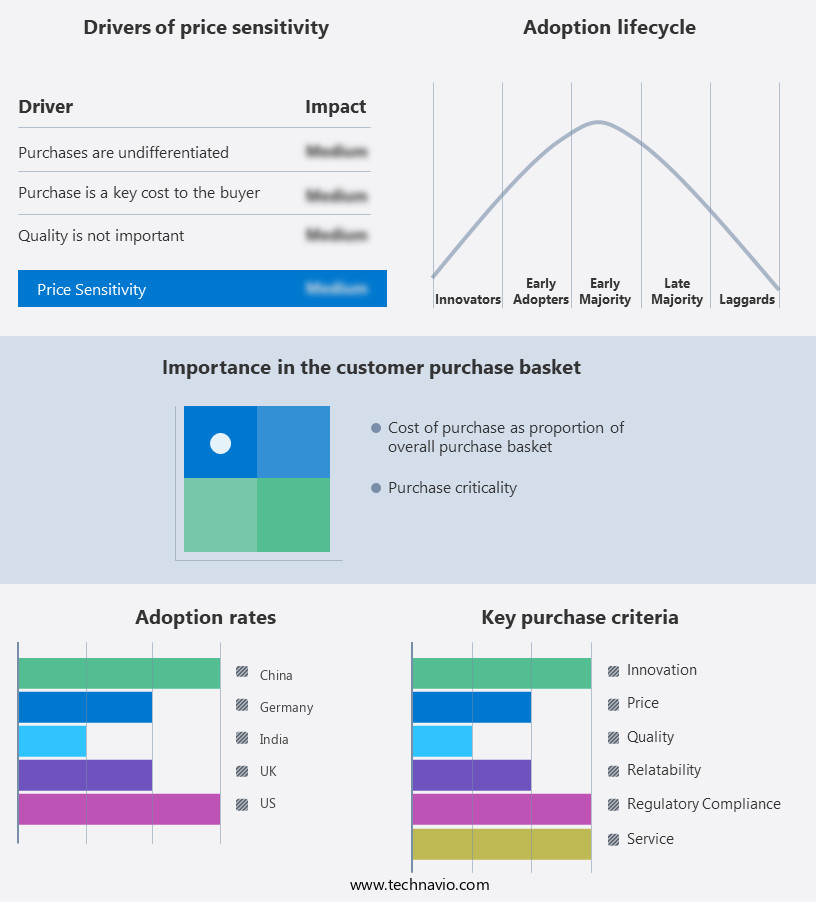
Customer Landscape of Healthcare Packaging Industry
Key Companies & Market Insights
Companies are implementing various strategies, such as strategic alliances, healthcare packaging market forecast, partnerships, mergers and acquisitions, geographical expansion, and product/service launches, to enhance their presence in the industry.
3M Co. - This company specializes in innovative healthcare packaging solutions, including the Surgical Clipper Professional, Filtek One Bulk Fill Restorative, and Clarity Advanced Ceramic Brackets, enhancing efficiency and safety in various medical applications.
The industry research and growth report includes detailed analyses of the competitive landscape of the market and information about key companies, including:
- 3M Co.
- Airnov Inc.
- Amcor Plc
- AmerisourceBergen Corp.
- AptarGroup Inc.
- Baxter International Inc.
- Becton Dickinson and Co.
- Cardinal Health Inc.
- Catalent Inc.
- CCL Industries Inc.
- DuPont de Nemours Inc.
- Gerresheimer AG
- KP Holding GmbH and Co. KG
- Placon Corp.
- Precision Concepts International
- SCHOTT AG
- Sealed Air Corp.
- Sonoco Products Co.
- West Pharmaceutical Services Inc.
- WestRock Co.
Qualitative and quantitative analysis of companies has been conducted to help clients understand the wider business environment as well as the strengths and weaknesses of key industry players. Data is qualitatively analyzed to categorize companies as pure play, category-focused, industry-focused, and diversified; it is quantitatively analyzed to categorize companies as dominant, leading, strong, tentative, and weak.
Recent Development and News in Healthcare Packaging Market
- In January 2024, Amcor plc, a global packaging company, announced the launch of its new PET (polyethylene terephthalate) bottle for pharmaceutical applications, named 'AmLite Digipak.' This innovative solution integrates digital technology with packaging, enabling real-time monitoring of medication temperature and expiry dates (Amcor press release, 2024).
- In March 2024, West Pharmaceutical Services, Inc. And Gerresheimer AG, two leading healthcare packaging providers, entered into a strategic partnership to expand their combined offerings in the prefillable syringe market. This collaboration aimed to enhance their product portfolios and cater to the growing demand for advanced drug delivery systems (West Pharmaceutical Services press release, 2024).
- In May 2025, Tetra Pak, a leading food processing and packaging solutions company, acquired a significant stake in Medipak Systems, a German healthcare packaging specialist. This investment strengthened Tetra Pak's presence in the healthcare sector and expanded its product offerings to include sterile packaging solutions (Tetra Pak press release, 2025).
- In the same month, the US Food and Drug Administration (FDA) approved the use of biodegradable PLA (polylactic acid) packaging for certain medical devices. This approval marked a significant shift towards more sustainable packaging solutions in the healthcare industry (FDA press release, 2025).
Research Analyst Overview
- The market is a dynamic and evolving industry that continues to innovate and adapt to the changing needs of the pharmaceutical sector. Gamma irradiation and e-beam sterilization are essential processes in ensuring the safety and efficacy of medical devices and pharmaceuticals. These sterilization methods are particularly crucial for single-use medical devices and certain pharmaceutical excipients that cannot be sterilized using conventional methods. Tamper-evident seals and child-resistant closures are essential components of secondary packaging, providing critical safety features for consumers. The market for tamper-evident seals is expected to grow at a significant rate due to increasing consumer awareness and regulatory requirements.
- According to a market research report, the global tamper-evident seals market is projected to reach a value of USD12.5 billion by 2025, growing at a compound annual growth rate (CAGR) of 6.5% during the forecast period. Pharmaceutical excipients, the inactive substances used in the formulation of drugs, require specialized packaging solutions to maintain their stability and efficacy. Shelf life extension is a significant concern for pharmaceutical companies, and secondary packaging plays a crucial role in achieving this goal. Packaging machinery is a vital investment for pharmaceutical and healthcare companies, enabling efficient production and ensuring regulatory compliance.
- E-beam sterilization offers several advantages over gamma irradiation, including lower energy consumption, shorter sterilization times, and the ability to sterilize complex shapes. However, the initial investment for e-beam sterilization systems is higher than that of gamma irradiation. Child-resistant closures and tamper-evident seals are essential for ensuring the safety of pharmaceuticals and medical devices, particularly for pediatric and geriatric populations. In conclusion, the market is a continuously evolving industry, with a focus on ensuring safety, efficacy, and regulatory compliance. Gamma irradiation and e-beam sterilization, tamper-evident seals, child-resistant closures, and secondary packaging are all critical components of this market, with ongoing research and innovation driving growth and development.
Dive into Technavio’s robust research methodology, blending expert interviews, extensive data synthesis, and validated models for unparalleled Healthcare Packaging Market insights. See full methodology.
|
Market Scope
|
|
Report Coverage
|
Details
|
|
Page number
|
184
|
|
Base year
|
2023
|
|
Historic period
|
2018-2022 |
|
Forecast period
|
2024-2028
|
|
Growth momentum & CAGR
|
Accelerate at a CAGR of 6.49%
|
|
Market growth 2024-2028
|
USD 53.9 billion
|
|
Market structure
|
Fragmented
|
|
YoY growth 2023-2024(%)
|
6.17
|
|
Key countries
|
US, China, Germany, UK, and India
|
|
Competitive landscape
|
Leading Companies, Market Positioning of Companies, Competitive Strategies, and Industry Risks
|
Request Free Sample
What are the Key Data Covered in this Healthcare Packaging Market Research and Growth Report?
- CAGR of the Healthcare Packaging industry during the forecast period
- Detailed information on factors that will drive the growth and forecasting between 2024 and 2028
- Precise estimation of the size of the market and its contribution of the industry in focus to the parent market
- Accurate predictions about upcoming growth and trends and changes in consumer behaviour
- Growth of the market across APAC, North America, Europe, Middle East and Africa, and South America
- Thorough analysis of the market’s competitive landscape and detailed information about companies
- Comprehensive analysis of factors that will challenge the healthcare packaging market growth of industry companies
We can help! Our analysts can customize this healthcare packaging market research report to meet your requirements.
Get in touch







![]() Get the report (PDF) sent to your email within minutes.
Get the report (PDF) sent to your email within minutes.
Complimentary full Excel data with your report purchase.